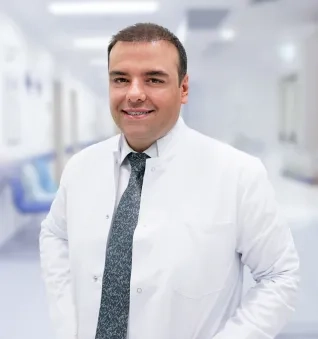Alo Yeditepe
Alo Yeditepe
Patched Solution for Umbilical Hernia
Yeditepe University Hospital General Surgery Specialist emphasizes that the risk of recurrence of umbilical hernia is significantly reduced thanks to the new patches developed in hernia surgeries. He states, 'Since a smaller incision is made in these operations, the surgery is shorter, postoperative pain is less, and the patient can be discharged on the same day.
• What kind of disease is a hernia?
Umbilical hernia is a condition in which abdominal organs or tissues protrude through the navel. The opening through which the hernia occurs is the site where the umbilical cord, responsible for the blood flow between the baby and the mother during pregnancy, entered the abdominal wall. It can be very small, to the extent that a person may not notice it, or it can grow to large sizes.
• Why does an umbilical hernia occur?
Umbilical hernias can be congenital or acquired later in life. They are more common in women, and obesity and repeated pregnancies often predispose individuals to their development.
• How is the treatment of umbilical hernia?
The treatment for all umbilical hernias in adults is a surgical procedure. When diagnosed, it is essential to undergo surgery without delay because there is a risk of strangulation in hernias. Strangulation of a hernia is manifested by severe pain when the hernia, which may have entered the abdominal cavity previously, does not go inside and causes intense pain. If the intestine has entered the hernia, surgery should be performed within a few hours, and the risk of emergency surgeries is always higher than that of planned surgeries.
• Are there different types of hernia surgery?
Hernias can be operated with open or closed (laparoscopic) methods. In the open method, there are various surgical techniques. The most accepted technique is hernia repairs done using a patch. It has been observed that hernias not repaired with a patch have a high recurrence rate over time.
• What is the patch technique?
During the surgery, patches are placed over or under the area where the hernia is located, i.e., inside the abdomen. In hernia surgeries performed by placing the patch inside the abdomen, the risk of recurrence is extremely low. In this method, a newly developed, specially designed type of patch can be used. Both sides of this patch are covered with different materials. The patch is placed inside the abdomen. Since the surface in contact with the abdominal cavity has a special structure, it does not adhere to the intestines. Because the patch placed inside the abdomen is inserted through a small incision in the abdomen and deployed inside like an umbrella, it covers the defect area up to a more distant area from the edges of the hernia. Since this method involves a mini incision of about 3 cm, there is minimal pain after the surgery, and the duration of the surgery is very short. Since the subcutaneous tissue is not freed, there is no accumulation of fluid similar to serum under the skin..
Generally, we have the chance to discharge the patient to their home on the day of the surgery. Patients return to their normal lives and work shortly after the procedure.
This content was prepared by Yeditepe University Hospitals Medical Editorial Board.
”
See Also
- What is a Liver Transplant, How is it Done? and Who is it For?
- Does Secondhand Smoke Increase the Risk of Breast Cancer?
- What is Gallbladder Surgery?
- Colorectal Cancers and Treatment Methods
- What are the Symptoms and Treatment Methods of Cirrhosis?
- Breast Cancer Diagnosis and Treatment Methods
- Swallowable Gastric Balloon
- What Are the Symptoms of Gallbladder Stones? How Is It Treated?
- 3 Major Developments Shaping Treatment in Colon Cancer
- Can Weight Loss Despite Not Dieting Be a Sign of Cancer?
- The Biggest Obstacle to Early Diagnosis of Breast Cancer: LACK OF INFORMATION
- Serious Risk Factor for Colon Cancer: Heredity
- He Came to Turkey to Get Rid of the Colostomy Bag
- Breast Protective Surgery Is Not Recommended in the Treatment of Multifocal Breast Cancer
- Does Breast Cancer Risk Decrease During Pregnancy and Breastfeeding?
- Breast Cancer Incidence Age Is Decreasing Day by Day
- Early Detection Is Cancer's Most Powerful Enemy
- Breast Cancer Has Dethroned Lung Cancer for The First Time! But, Why?
- Emotional Stress May Affect Risk of Recurrence in Breast Cancer
- Although Her Fears Prevented Her from Going to the Hospital, She Managed to Beat Breast Cancer at the Age of 70
- Age of Breast Cancer Prevalence Falls, yet Mortality Declines
- Breast Cancer Screening Applications Decreased by 10% Before the Pandemic
- Facts About Breast Cancer
- Liver Cancer (Tumor) and Treatment
- Gallbladder Stones
- What Is Appendicitis?
- Hemorrhoid Treatment
- Questions About Gastroenterology Surgery
- Surgery for Breast Cancer and Breast Aesthetics Can Be Performed Simultaneously
- What are the Types of Obesity Surgeries?
- Questions About Obesity Surgery
- A New Era in Obesity Surgery
- Overweight
- Are Obesity Surgeries Risky?
- New Study Surprised: “Mortality Increased in Breast Cancer Cases Under the Age of 40”
Alo Yeditepe







